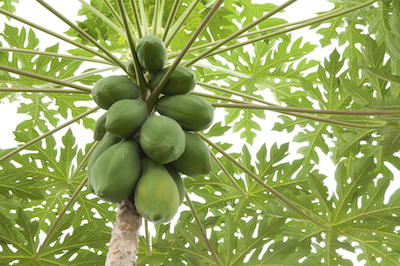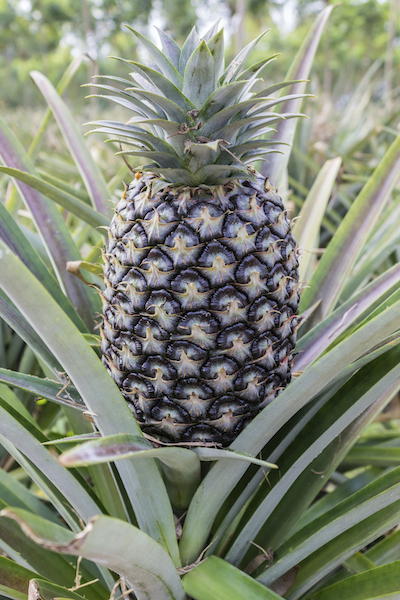
Chapter 2. Plants Serve Up Useful Enzymes
Plants Serve Up Useful Enzymes

Read the article below. Then complete the comprehension questions that follow.

Biodiversity yields medicinal compounds
The biodiversity of the plant world has provided us with fascinating plant remedies. Some have been harnessed by traditional healers and native people for thousands of years. One such source is the papaya.
Papayas grow in bundles on lush, tropical trees. When yellow and ripe, they are a delicious treat. Yet it’s the green, unripe fruit that is harvested for its potent enzyme content. When shallow cuts are made on the neck of an unripe papaya, a thick milky substance called latex slowly seeps out. This latex is collected, purified, and dried to make powdered papain.
Papain is marketed as a dietary supplement—primarily for use as a digestive aid. It eats away at proteins and helps break down food in your stomach. (See the box below that describes other uses of papain.) It belongs to a class of plant-derived medicinal compounds called cystiene proteases. As we will learn, these help the body digest food and also can be found in kiwi and pineapple.
How cysteine proteases work
Papain is a superfamily of proteases—a special class of enzymes that break down the peptide bonds that hold proteins together. Papain is a “cysteine protease hydrolase” enzyme, which means the active site contains a cysteine molecule. It’s this cysteine molecule which helps breaks down peptide bonds.
Bromelain is the family of cysteine proteases extracted from pineapple. It is usually prepared from cooled pineapple juice, and—like papain—is sold as a digestive aid.
The science behind traditional plant medicine
Papaya and pineapple have been used by native healers for a very long time. In South America, papaya extract is still used to treat stings from jellyfish, stingrays, bees, wasps, and mosquitoes. It can help breakdown proteins in the toxins. Studies have recently shown that both papain and bromelain can have anti-inflammatory benefits.

Much of the information we have about plant medicines like pineapple and papaya extract come from interviews with native healers. This means plant preparations are often based on tradition rather than clinical trials and scientific methodology. But in the case of papain and bromelain, there are also a few clinical studies supporting health benefits—although only to a limited extent. There is a larger body of preclinical and biochemical research that shows how these enzymes function. From cancer treatment to the absorption of antibiotics, several applications are being explored for cysteine protease enzymes—especially those from pineapple.
Are they safe?
There are no concerns about the use of papain as a meat tenderizer or digestive aid, yet the United States Food and Drug Administration (FDA) is concerned about its use in over-the-counter topical medications. These concerns include the possibility of vision loss (from using eye drops and contact solutions that contain papain). In addition, people with latex allergies may also develop allergic reactions to the topical use of papain.
Like papain, bromelain is generally regarded as safe by the FDA. Yet whenever you purchase medicinal plant extracts—an especially when you mix them with prescription or over-the-counter drugs—it’s best to first check with a doctor.
Papain's Other Uses
Papain properties have led to many uses. It’s ability to break down proteins makes it a good meat tenderizer. It is also the main ingredient of “Papacarie,” a gel used for removing plaque on teeth. Scientists use papain to help separate cells from each other when preparing cell cultures in the laboratory. It works by breaking down the extracellular matrix that connects cells to each other. Another use of papain is in “Accuzyme” – a preparation used to clean up dead tissue in the care of wounds. In Australia, you can also find papain as the main ingredient in “Stop Itch,” a popular first aid cream.
© 2015 WH Freeman and Company
2.1 Comprehension Questions
Answer the following questions to demonstrate your understanding of the article.
1.
The enzyme papain is derived from unripe _______.
| A. |
| B. |
| C. |
| D. |
| E. |
2.
Select the missing phrase:
Papain and bromelain belong to a special class of enzymes known as .
3.
Fill in the Blank:
Enzymes, such as papain, are able to break bonds, which hold together amino acids in proteins.
4.
True/False:
The United States Food and Drug Administration (FDA) has concerns about the safety of both papain and bromelain since they have a high degree of toxicity when used in their raw state.
5.
According to the article, what are some of papain's many uses? Check all that apply.
ingredient in a gel that removes tooth plaque
ingredient in most artificially-flavored fruit beverages
ingredient used in preparations for cleaning up dead tissue from wounds
ingredient in commercial meat tenderizer
ingredient in biosynthetic insulin
6.
What is the action of enzymes, and why are they important in the physiology of an organism?
| A. |
| B. |
| C. |
| D. |
| E. |
7.
What is the action of papain and bromelain?
| A. |
| B. |
| C. |
| D. |
| E. |
8.
As you read in Chapter 2: Chemistry, enzymes are very specific about which substrate molecules they bind with. A good analogy that describes an enzyme and substrate is:
| A. |
| B. |
| C. |
| D. |
| E. |
9.
For years, native healers in South America used papaya extract to treat stings from jellyfish, stingrays, bees, and wasps. What can you conclude about the chemical composition of the toxins in these animals' stings?
| A. |
| B. |
| C. |
| D. |
| E. |
10.

The above diagram illustrates the steps that occur during a chemical reaction catalyzed by an enzyme (in this case, the enzyme lactase and the substrate lactose); however, the steps are not shown in the correct order.
Put the steps of the reaction in the correct order by 1) clicking the step/description on the left, and then 2) matching it to the letter of the figure that illustrates that step on the right.
Step 1: Exposed atoms in the active site attract the substrate. Step 2: The substrate fits into the active site; the bond between the simple sugars in lactose is broken. Step 3: The enzyme (lactase) breaks down the substrate into two simple sugar molecules (glucose and galactose) and releases them. | A C B |
| Correct Matches: | |
Activity results are being submitted...